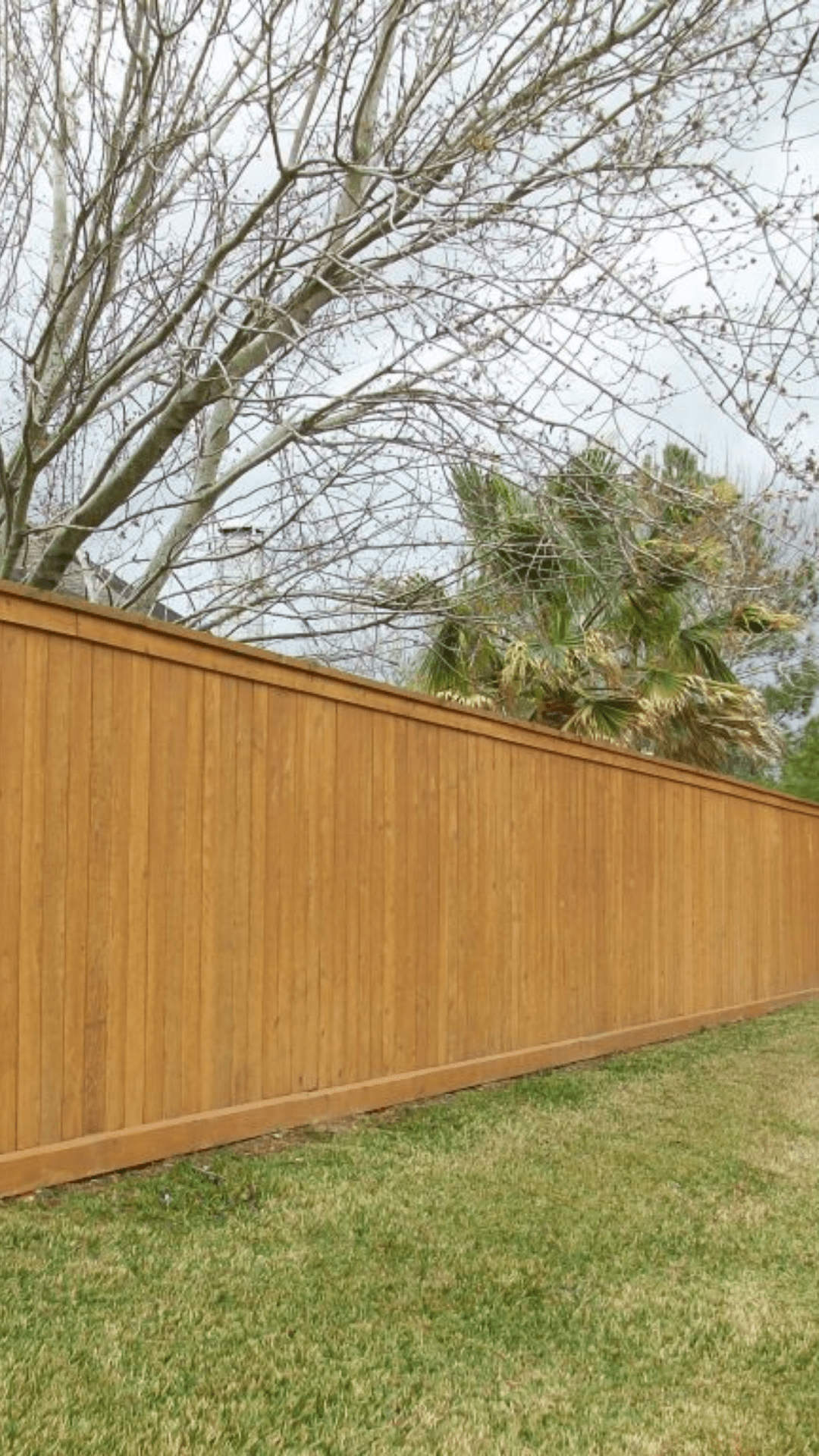Don’t Power Wash Your Fence | Plano Fence Restoration Experts
Many Plano homeowners think power washing is the best way to clean a fence before staining — but that couldn’t be further from the truth. When you don’t power wash fence wood, you protect the natural fibers, prevent scarring, and ensure the stain lasts for years.
At Fence Makeovers, we’ve seen hundreds of fences across Plano, Allen, Frisco, and McKinney ruined by high-pressure cleaning. It might look clean at first, but the damage left behind can be permanent. In many cases, the only way to fix it is by using a solid latex stain that covers the scars left by the pressure washer.
Let’s break down what really happens when you power wash, why you should don’t power wash fence boards, and what you can safely do instead.
What Happens When You Power Wash a Fence

When water hits a fence at 2,000–3,000 PSI, it’s not cleaning — it’s carving. High-pressure water can literally chew through soft wood fibers, leaving visible gouges, streaks, and swirl marks that look like graffiti.
Take a look at the photo. Those pale streaks aren’t paint — they’re scars. The pressure washer stripped the top layer of the wood, exposing raw fibers underneath.
Once that surface damage occurs, your fence can’t absorb stain evenly. Oil-based stains — which penetrate deep into the wood — will soak in unevenly, leaving blotches and light patches everywhere. The wood is also more vulnerable to water and sun damage after being gouged.
Even sanding often won’t fix it. The fibers are permanently raised and torn. Once it’s damaged, the only way to hide those scars is with a solid latex stain, which covers the imperfections like paint.
That’s why at Fence Makeovers, we always say: don’t power wash fence boards — ever.
Why Fence Makeovers Says “Don’t Power Wash Fence”
We hear this question all the time: “Why don’t you just pressure wash it?” The short answer is — because we care about your fence’s long-term health, not just how it looks today.
Our goal is to help your fence last for years, look beautiful, and stay structurally strong. Power washing might seem quick, but it damages the wood’s surface and shortens its lifespan.
When you don’t power wash fence wood, you avoid:
-
Raised grain and splintering
-
Deep streaks that never disappear
-
Softened fibers that absorb moisture unevenly
-
The need for heavy, paint-like coatings just to hide the damage
At Fence Makeovers, we use a gentle cleaning method instead — one that removes dirt, mildew, and discoloration without tearing into the wood. Think of it like washing your car: you wouldn’t blast it with a pressure washer and expect the paint to hold up. Your fence deserves the same care.
The Real Cost of Power Washing Damage
It’s easy to underestimate how much high-pressure cleaning can really cost. A rental power washer might run you $50 for the day, but repairing the damage could cost hundreds more.
Here’s what typically happens after someone power washes their fence too hard:
-
Raised fibers that stay fuzzy and absorb water
-
Permanent streaking that shows through stains
-
Deep cuts that turn gray quickly from sun exposure
-
Uneven absorption that ruins the final finish
We’ve seen this time and again across Plano, Allen, Frisco, and Richardson. Homeowners mean well — they just want their fence to look fresh. But one afternoon with too much pressure, and suddenly that natural wood finish is gone forever.
After that, oil-based stains are no longer an option. The wood can’t absorb stain evenly, so the only fix is a solid latex stain to cover the marks.

The Right Way to Clean a Fence Before Staining
The good news? You can clean a fence without power washing. It just takes the right technique.
Here’s how we safely clean fences at Fence Makeovers:
-
Inspect the Fence – We start by assessing the condition of your fence to determine the right cleaner and rinse method.
-
Apply a Specialized Cleaner – We use an bleach solution that lifts dirt, algae, and old residue from the wood surface.
-
Low-Pressure Rinse – Instead of blasting, we use a gentle rinse 40-60 PSI to remove buildup without damaging fibers.
-
Drying Time – We allow proper dry time before staining so the finish bonds perfectly to the wood.
When done properly, this process keeps your fence’s natural texture intact and prepares it for stain without streaks or damage.
Real Example: Power Wash Fence Damage in Plano

Here’s a real story from right here in Plano, TX.
A homeowner wanted to freshen up their fence before selling their home. They rented a pressure washer and started cleaning at full blast. Within minutes, the boards were streaked with light marks. It looked like someone had scribbled all over it.
When we arrived, we explained what had happened and why those scars wouldn’t go away. We used a Behr solid latex stain in Walnut, which completely covered the streaking and gave the fence a rich, even finish.
The result was stunning — but it came at the cost of losing that natural wood-grain look. Had they called us first, a gentle wash and oil-based stain would’ve preserved the beauty of the original wood.
That’s why we keep saying it: don’t power wash fence panels — you’ll save time and money by doing it the right way from the start.
Remember: the key is in the pressure setting and the technique. Just because a tool can reach 3,000 PSI doesn’t mean it should. Most fences need less than 60 PSI to be cleaned safely.
Choosing the Right Stain After Damage
Once a fence has been power washed, the only way to cover the scars is with a solid latex stain. At Fence Makeovers, we use high-quality Behr and Wood Defender solid latex stains in two custom shades — Sable and Walnut.
These colors are rich, durable, and formulated to fully cover power washing scars while adding UV and weather protection. The result is a uniform, professional finish that gives your fence a second life.
If your fence looks like someone drew on it with chalk after power washing, a solid latex stain is your best option for restoration.
However, if your fence hasn’t been damaged yet, we can still use a penetrating oil-based stain that highlights the natural wood grain. That’s why we always recommend calling us before using any high-pressure equipment — once the damage is done, there’s no going back.
Don’t Power Wash Fence — What to Do Instead
So if you shouldn’t power wash, what should you do instead?
Here’s the right approach:
-
Use a professional fence cleaning solution designed for wood.
-
Rinse with low pressure (under 60 PSI).
-
Let the fence dry completely before staining.
-
Apply stain evenly using a brush, roller, or professional sprayer.
If your fence is already stained or sealed, a light rinse and inspection may be all that’s needed before applying a new coat.
At Fence Makeovers, we tailor every cleaning to the fence’s condition, wood type, and age. It’s a process that preserves your investment rather than destroys it.
Don’t Pay More – Just Restore!
Oil-Based vs. Latex Stains —
What’s Next?
If your fence is still in good shape and hasn’t been damaged, you might be wondering whether an oil-based stain or latex stain is best.
In our next article, we’ll cover exactly that:
👉 Oil-Based vs. Latex Stains — Which Lasts Longer in Texas Heat
You’ll learn which option holds up better under Plano’s extreme summer sun and why choosing the right stain now saves you time and money later.
Let Fence Makeovers Clean and Restore Your Fence the Right Way
Before you rent that pressure washer, call Fence Makeovers. We’ll inspect your fence, explain your best options, and give you a free estimate for professional cleaning and staining.
We proudly serve homeowners in Plano, Allen, Frisco, McKinney, and Richardson, providing honest advice and expert fence restoration every time.
👉 Get Your Free Estimate or check out Our Fence Cleaning and Staining Page
Your fence is one of the first things people notice about your home — make sure it’s protected, not damaged. Trust Fence Makeovers to restore your fence safely and beautifully.
Trusted. Proven. Rated A+ by the BBB.
Looking for a fence company you can trust? Fence Makeovers is proud to hold an A+ rating with the Better Business Bureau.




